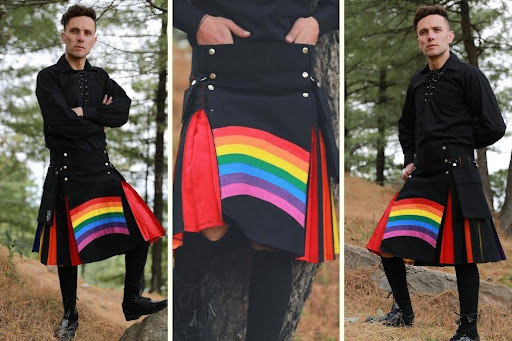
The Pride Kilt | A Symbol of Inclusivity, Identity & Celebration
In recent years, the traditional Scottish garment known as the kilt has taken on a new and vibrant form – the Pride Kilt. This unique adaptation of the classic attire serves not only as a symbol of Scottish heritage but also as a powerful statement of inclusivity, identity, and celebration within the LGBTQ+ community. In this exploration, we delve into the origins of the Pride Kilt, its significance, and the impact it has had on individuals and communities around the world.
The Traditional Scottish Kilt
To understand the evolution of the Pride Kilt, it is essential to first appreciate the history and cultural significance of the traditional Scottish kilt. Originating in the 16th century, kilts have been a symbol of Scottish identity, worn proudly by men as a reflection of their clan and heritage. The distinct tartan patterns and pleated design make kilts a unique and recognizable garment, often associated with traditional Scottish events and celebrations.
The Emergence of the Pride Kilt
The idea of the Pride Kilt emerged as a response to the growing movement for LGBTQ+ rights and visibility. The LGBTQ+ community sought ways to express their identity and pride, not just during specific events but as part of their everyday lives. The kilt, with its rich history and cultural significance, presented itself as a canvas for this expression. Designers and activists began incorporating rainbow-colored tartans into the traditional kilt design, creating a vibrant and symbolic garment that represented the diverse spectrum of sexual orientations and gender identities within the LGBTQ+ community. The Pride Kilt thus became a fusion of tradition and modernity, bridging the gap between heritage and the evolving landscape of identity expression.
Symbolism & Representation
The Pride Kilt is more than just a colorful piece of clothing; it serves as a symbol of acceptance, equality, and celebration. Each color in the rainbow tartan holds significance, representing different aspects of the LGBTQ+ community. For instance, red symbolizes life, orange represents healing, yellow signifies sunlight, green represents nature, blue symbolizes serenity, and violet stands for spirit. The inclusion of these colors in the kilt design not only celebrates the diversity of the LGBTQ+ community but also serves as a visual reminder of the ongoing struggle for equality and acceptance. The Pride Kilt becomes a form of silent activism, allowing individuals to express their identity proudly and challenge societal norms surrounding gender and sexuality.
Impact on Individuals
Wearing the Pride Kilt has a profound impact on individuals within the LGBTQ+ community. It provides a sense of empowerment, allowing individuals to embrace their identity without fear of judgment. The kilt becomes a visible and tangible expression of self-affirmation, fostering a sense of belonging and community among those who may have felt marginalized or invisible.
Moreover, the Pride Kilt has been embraced by allies and supporters, further amplifying its impact. By donning the colorful garment, individuals outside the LGBTQ+ community show solidarity and contribute to creating a more inclusive society. The kilt becomes a conversation starter, encouraging dialogue and understanding between people of diverse backgrounds and perspectives.
Cultural Appropriation or Appreciation?
As the popularity of the Pride Kilt grows, questions arise about cultural appropriation versus cultural appreciation. Some argue that adapting a traditional Scottish garment to represent LGBTQ+ pride may dilute its cultural significance. However, proponents argue that the fusion of tradition and modernity in the Pride Kilt serves to evolve cultural expressions, creating a more inclusive and accepting society.
It is crucial to navigate this conversation with sensitivity and respect for the cultural roots of the traditional Scottish kilt. Engaging in open dialogue and seeking input from both the Scottish community and the LGBTQ+ community can contribute to a better understanding of the nuanced issues surrounding cultural representation and expression.
The Global Reach of the Pride Kilt
The Pride Kilt has transcended geographical boundaries and cultural contexts, becoming a global symbol of LGBTQ+ pride and visibility. From Pride parades in major cities to everyday wear in diverse communities, the kilt has found its place as a versatile and impactful garment. Its reach extends beyond the LGBTQ+ community, making a statement about the universal values of acceptance, love, and celebration of diversity.
Challenges & Controversies
Despite its positive impact, the Pride Kilt has not been without its challenges and controversies. Some critics argue that the commercialization of the kilt for LGBTQ+ pride may undermine the authenticity of the gesture. Additionally, debates surrounding the intersectionality of identity and the need for broader representation within the LGBTQ+ community continue to shape the discourse around the Pride Kilt. Addressing these challenges requires a nuanced understanding of the complexities involved in using cultural symbols for social and political purposes. Balancing celebration with cultural respect remains a delicate task, one that requires ongoing dialogue and collaboration between stakeholders.
Conclusion
In conclusion, the Pride Kilt stands as a powerful symbol of inclusivity, identity, and celebration within the LGBTQ+ community. Its evolution from the traditional Scottish kilt to a vibrant expression of pride reflects the dynamic interplay between culture, identity, and activism. As the kilt continues to make its mark globally, it prompts important conversations about representation, acceptance, and the ever-evolving landscape of identity expression. The Pride Kilt is more than a garment; it is a testament to the resilience and creativity of individuals who seek to challenge societal norms and create a world where everyone can proudly embrace their authentic selves. Whether worn at Pride events, cultural festivals, or in everyday life, the Pride Kilt serves as a beacon of hope, reminding us all of the power of visibility, acceptance, and love.







